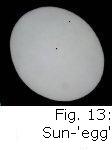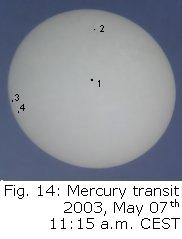 Deutsch Deutsch |
Transit of Mercury |
Transit of Mercury In 2003 at 7th of May many telescopes were aligned with the sun: Between 7:11 and 12:33 o'clock Central European Summer Time a Mercury transit over the sun disk took place. I was lucky to observe this event with my telescope at almost cloudless sky on a flat roof of the Technical University of Darmstadt. It was my first observation of the sun and I used the projection method in addition.
In 2003 at 7th of May many telescopes were aligned with the sun: Between 7:11 and 12:33 o'clock Central European Summer Time a Mercury transit over the sun disk took place. I was lucky to observe this event with my telescope at almost cloudless sky on a flat roof of the Technical University of Darmstadt. It was my first observation of the sun and I used the projection method in addition.Taking the photo  Since reproduction of the sun appears on a screen, there are in principle two possibilities to to preserve that observation: You copy it or you take a photo. Since the screen is joined with the telescope trace the migration of the sun, this cannot happen without vibrations. The positions of sun inclusive planet will shift at the first contact of a pen at the screen. If you try to take a photo of the picture on the screen, the next difficulty arises. In principle it is not possible to align the camera perpendicularly to the screen without optical aids: The sun is distorted to an ellipse. Using digitized pictures the photo can be equalized with the help of a graphic software.
Since reproduction of the sun appears on a screen, there are in principle two possibilities to to preserve that observation: You copy it or you take a photo. Since the screen is joined with the telescope trace the migration of the sun, this cannot happen without vibrations. The positions of sun inclusive planet will shift at the first contact of a pen at the screen. If you try to take a photo of the picture on the screen, the next difficulty arises. In principle it is not possible to align the camera perpendicularly to the screen without optical aids: The sun is distorted to an ellipse. Using digitized pictures the photo can be equalized with the help of a graphic software.My observations The picture, taken at 11:15 o'clock Central European Summer Time (fig. 14), looks approximately as a circular disk and has a relatively good resolution. At this page I present you the picture relatively small. If you want to regard the transit of Mercury enlarged on your display, (file size approx.160 KB) use a mouse-click on the picture. Graphic data: aperture number = 8, t = 1/1600 second, focal length 7mm, no white alignment, dimension of picture 1360 x 1024 pixels .  First you recognize near the centre of sun a large spot (1). You will find Mercury in the upper quarter as small black disk (2). At the left hand side of the picture, easily below the sun centre, you can discover 2 further sunspots (3 and 4). The relative size of Sun and Mercury is remarkable: The .5 mm measuring disk of the Mercury is in truth a planet with a diameter of 4800 km, according to 2/5 of Earth. In this morning I photographed Mercury at different times. Take the picture composition (fig. 15) to reconstruct the movement of the planet. Enlargement of the picture can be done by mouse-click too (file size approx.. 100 KB).
First you recognize near the centre of sun a large spot (1). You will find Mercury in the upper quarter as small black disk (2). At the left hand side of the picture, easily below the sun centre, you can discover 2 further sunspots (3 and 4). The relative size of Sun and Mercury is remarkable: The .5 mm measuring disk of the Mercury is in truth a planet with a diameter of 4800 km, according to 2/5 of Earth. In this morning I photographed Mercury at different times. Take the picture composition (fig. 15) to reconstruct the movement of the planet. Enlargement of the picture can be done by mouse-click too (file size approx.. 100 KB). Due to the illustration laws the telescope represents all pictures inversely and in truth Mercury will pass the sun in the lower quarter. A reflection at the horizontal axis represents conditions correctly. Determination of the sun diameter Back to the start of page |
|
| Copyright by Hans Joachim Ilgen since 1950 | |